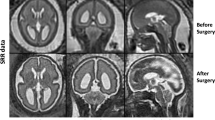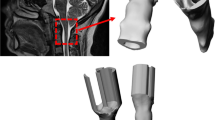Abstract
While the degree of cerebellar tonsillar descent is considered the primary radiologic marker of Chiari malformation type I (CMI), biomechanical forces acting on the brain tissue in CMI subjects are less studied and poorly understood. In this study, regional brain tissue displacement and principal strains in 43 CMI subjects and 25 controls were quantified using a magnetic resonance imaging (MRI) methodology known as displacement encoding with stimulated echoes (DENSE). Measurements from MRI were obtained for seven different brain regions—the brainstem, cerebellum, cingulate gyrus, corpus callosum, frontal lobe, occipital lobe, and parietal lobe. Mean displacements in the cerebellum and brainstem were found to be 106 and 64% higher, respectively, for CMI subjects than controls (p < .001). Mean compression and extension strains in the cerebellum were 52 and 50% higher, respectively, in CMI subjects (p < .001). Brainstem mean extension strain was 41% higher in CMI subjects (p < .001), but no significant difference in compression strain was observed. The other brain structures revealed no significant differences between CMI and controls. These findings demonstrate that brain tissue displacement and strain in the cerebellum and brainstem might represent two new biomarkers to distinguish between CMI subjects and controls.








Similar content being viewed by others
References
Adams, A. L., H. J. Kuijf, M. A. Viergever, P. R. Luijten, and J. J. M. Zwanenburg. Quantifying cardiac-induced brain tissue expansion using DENSE. NMR Biomed. 32(2):e4050, 2019.
Adams, A. L., M. A. Viergever, P. R. Luijten, and J. J. M. Zwanenburg. Validating faster DENSE measurements of cardiac-induced brain tissue expansion as a potential tool for investigating cerebral microvascular pulsations. Neuroimage 208:116466, 2020.
Aletras, A. H., S. Ding, R. S. Balaban, and H. Wen. DENSE: displacement encoding with stimulated echoes in cardiac functional MRI. J. Magn. Reson. 137(1):247–252, 1999.
Alperin, N., J. R. Loftus, C. J. Oliu, A. M. Bagci, S. H. Lee, B. Ertl-Wagner, B. Green, and R. Sekula. Magnetic resonance imaging measures of posterior cranial fossa morphology and cerebrospinal fluid physiology in Chiari malformation type I. Neurosurgery 75(5):515–522, 2014; (discussion 522).
Alperin, N., A. Sivaramakrishnan, and T. Lichtor. Magnetic resonance imaging-based measurements of cerebrospinal fluid and blood flow as indicators of intracranial compliance in patients with Chiari malformation. J. Neurosurg. 103(1):46–52, 2005.
Arnautovic, K. I., D. Muzevic, B. Splavski, and F. A. Boop. Association of increased body mass index with Chiari malformation Type I and syrinx formation in adults. J. Neurosurg. 119(4):1058–1067, 2013.
Bolognese, P. A., A. Brodbelt, A. B. Bloom, and R. W. Kula. Chiari I malformation: opinions on diagnostic trends and controversies from a panel of 63 international experts. World Neurosurg. 130:e9–e16, 2019.
Chavez, A., M. Roguski, A. Killeen, C. Heilman, and S. Hwang. Comparison of operative and non-operative outcomes based on surgical selection criteria for patients with Chiari I malformations. J. Clin. Neurosci. 21(12):2201–2206, 2014.
Clarke, E. C., D. F. Fletcher, M. A. Stoodley, and L. E. Bilston. Computational fluid dynamics modelling of cerebrospinal fluid pressure in Chiari malformation and syringomyelia. J. Biomech. 46(11):1801–1809, 2013.
Clarke, E. C., M. A. Stoodley, and L. E. Bilston. Changes in temporal flow characteristics of CSF in Chiari malformation type I with and without syringomyelia: implications for theory of syrinx development. J. Neurosurg. 118(5):1135–1140, 2013.
Cousins, J., and V. Haughton. Motion of the cerebellar tonsils in the foramen magnum during the cardiac cycle. AJNR Am. J. Neuroradiol. 30(8):1587–1588, 2009.
Dawes, B. H., R. A. Lloyd, J. M. Rogers, J. S. Magnussen, L. E. Bilston, and M. A. Stoodley. Cerebellar tissue strain in Chiari malformation with headache. World Neurosurg. 134:e74–e81, 2019.
Elster, A. D., and M. Chen. Chiari I malformations: clinical and radiologic reappraisal. Radiology 183(2):347–353, 1992.
Eppelheimer, M. S., J. R. Houston, J. R. Bapuraj, R. Labuda, D. M. Loth, A. M. Braun, N. J. Allen, S. Heidari Pahlavian, D. Biswas, A. Urbizu, B. A. Martin, C. O. Maher, P. A. Allen, and F. Loth. A retrospective 2D morphometric analysis of adult female chiari type I patients with commonly reported and related conditions. Front Neuroanat. 12:2, 2018.
Fukuoka, T., Y. Nishimura, M. Hara, S. Haimoto, K. Eguchi, S. Yoshikawa, T. Wakabayashi, and H. J. Ginsberg. Chiari type 1 malformation-induced intracranial hypertension with diffuse brain edema treated with foramen magnum decompression: a case report. NMC Case Rep. J. 4(4):115–120, 2017.
Hofmann, E., M. Warmuth-Metz, M. Bendszus, and L. Solymosi. Phase-contrast MR imaging of the cervical CSF and spinal cord: volumetric motion analysis in patients with Chiari I malformation. Am. J. Neuroradiol. 21(1):151, 2000.
Houston, J. R., P. A. Allen, J. M. Rogers, M.-C. Lien, N. J. Allen, M. L. Hughes, J. R. Bapuraj, M. S. Eppelheimer, F. Loth, M. A. Stoodley, S. J. Vorster, and M. G. Luciano. Type I Chiari malformation, RBANS performance, and brain morphology: connecting the dots on cognition and macrolevel brain structure. Neuropsychology 33(5):725–738, 2019.
Houston, J. R., M. S. Eppelheimer, S. H. Pahlavian, D. Biswas, A. Urbizu, B. A. Martin, J. R. Bapuraj, M. Luciano, P. A. Allen, and F. Loth. A morphometric assessment of type I Chiari malformation above the McRae line: a retrospective case-control study in 302 adult female subjects. J. Neuroradiol. 45(1):23–31, 2018.
Iffrig, E., J. S. Wilson, X. Zhong, and J. N. Oshinski. Demonstration of circumferential heterogeneity in displacement and strain in the abdominal aortic wall by spiral cine DENSE MRI. J. Magn. Reson. Imaging 49(3):731–743, 2019.
Kim, D., W. D. Gilson, C. M. Kramer, and F. H. Epstein. Myocardial tissue tracking with two-dimensional cine displacement-encoded MR imaging: development and initial evaluation. Radiology 230(3):862–871, 2004.
Lawrence, B. J., M. Luciano, J. Tew, R. G. Ellenbogen, J. N. Oshinski, F. Loth, A. P. Culley, and B. A. Martin. Cardiac-related spinal cord tissue motion at the foramen magnum is increased in patients with type I Chiari malformation and decreases postdecompression surgery. World Neurosurg. 116:e298–e307, 2018.
Leung, V., J. S. Magnussen, M. A. Stoodley, and L. E. Bilston. Cerebellar and hindbrain motion in Chiari malformation with and without syringomyelia. J. Neurosurg. Spine 24(4):546–555, 2016.
Lloyd, R. A., D. F. Fletcher, E. C. Clarke, and L. E. Bilston. Chiari malformation may increase perivascular cerebrospinal fluid flow into the spinal cord: a subject-specific computational modelling study. J. Biomech. 65:185–193, 2017.
Meadows, J., M. Kraut, M. Guarnieri, R. I. Haroun, and B. S. Carson. Asymptomatic Chiari Type I malformations identified on magnetic resonance imaging. J. Neurosurg. 92(6):920–926, 2000.
Milhorat, T. H., M. W. Chou, E. M. Trinidad, R. W. Kula, M. Mandell, C. Wolpert, and M. C. Speer. Chiari I malformation redefined: clinical and radiographic findings for 364 symptomatic patients. Neurosurgery 44(5):1005–1017, 1999.
Nwotchouang, B. S. T., M. S. Eppelheimer, P. Bishop, D. Biswas, J. M. Andronowski, J. R. Bapuraj, D. Frim, R. Labuda, R. Amini, and F. Loth. Three-dimensional CT morphometric image analysis of the clivus and sphenoid sinus in Chiari malformation type I. Ann. Biomed. Eng. 47(11):2284–2295, 2019.
Nwotchouang, B. S. T., M. S. Eppelheimer, D. Biswas, S. H. Pahlavian, X. Zhong, J. N. Oshinski, D. L. Barrow, R. Amini, and F. Loth. Accuracy of cardiac-induced brain motion measurement using displacement-encoding with stimulated echoes (DENSE) magnetic resonance imaging (MRI): a phantom study. Magn. Reson. Med. 2020. https://doi.org/10.1002/mrm.28490.
Nwotchouang, B. S. T., M. S. Eppelheimer, A. Ibrahimy, J. R. Houston, D. Biswas, R. Labuda, J. R. Bapuraj, P. A. Allen, D. Frim, and F. Loth. Clivus length distinguishes between asymptomatic healthy controls and symptomatic adult women with Chiari malformation type I. Neuroradiology 62:1389–1400, 2020.
Pahlavian, S. H., J. Oshinski, X. Zhong, F. Loth, and R. Amini. Regional quantification of brain tissue strain using displacement-encoding with stimulated echoes magnetic resonance imaging. J. Biomech. Eng. 2018. https://doi.org/10.1115/1.4040227.
Pujol, J., C. Roig, A. Capdevila, A. Pou, J. L. Marti-Vilalta, J. Kulisevsky, A. Escartin, and G. Zannoli. Motion of the cerebellar tonsils in Chiari type I malformation studied by cine phase-contrast MRI. Neurology 45(9):1746–1753, 1995.
Reese, T. G., D. A. Feinberg, J. Dou, and V. J. Wedeen. Phase contrast MRI of myocardial 3D strain by encoding contiguous slices in a single shot. Magn. Reson. Med. 47(4):665–676, 2002.
Roberts, D. A.-O., D. A.-O. Asemani, P. A.-O. Nietert, M. A.-O. Eckert, D. A.-O. Inglesby, J. A.-O. Bloomberg, M. A.-O. George, and T. A.-O. Brown. Prolonged microgravity affects human brain structure and function. AJNR Am. J. Neuroradiol. 40(11):1878–1885, 2019.
Sloots, J. J., G. J. Biessels, and J. J. M. Zwanenburg. Cardiac and respiration-induced brain deformations in humans quantified with high-field MRI. Neuroimage 210:116581, 2020.
Smith, B. W., J. Strahle, J. R. Bapuraj, K. M. Muraszko, H. J. Garton, and C. O. Maher. Distribution of cerebellar tonsil position: implications for understanding Chiari malformation. J. Neurosurg. 119(3):812–819, 2013.
Soellinger, M., A. K. Rutz, S. Kozerke, and P. Boesiger. 3D cine displacement-encoded MRI of pulsatile brain motion. Magn. Reson. Med. 61(1):153–162, 2009.
Spottiswoode, B. S., X. Zhong, A. T. Hess, C. M. Kramer, E. M. Meintjes, B. M. Mayosi, and F. H. Epstein. Tracking myocardial motion from cine DENSE images using spatiotemporal phase unwrapping and temporal fitting. IEEE Trans. Med. Imaging 26(1):15–30, 2007.
Strahle, J., K. M. Muraszko, J. Kapurch, J. R. Bapuraj, H. J. Garton, and C. O. Maher. Natural history of Chiari malformation Type I following decision for conservative treatment. J. Neurosurg. Pediatr. 8(2):214–221, 2011.
Terem, I., W. W. Ni, M. Goubran, M. S. Rahimi, G. Zaharchuk, K. W. Yeom, M. E. Moseley, M. Kurt, and S. J. Holdsworth. Revealing sub-voxel motions of brain tissue using phase-based amplified MRI (aMRI). Magn. Reson. Med. 80(6):2549–2559, 2018.
Wehner, G. J., L. Jing, C. M. Haggerty, J. D. Suever, J. Chen, S. M. Hamlet, J. A. Feindt, W. Dimitri-Mojsejenko, M. A. Fogel, and B. K. Fornwalt. Comparison of left ventricular strains and torsion derived from feature tracking and DENSE CMR. J. Cardiovasc. Magn. Reson. 20(1):63, 2018.
Wolpert, S. M., R. A. Bhadelia, A. R. Bogdan, and A. R. Cohen. Chiari I malformations: assessment with phase-contrast velocity MR. Am. J. Neuroradiol. 15(7):1299–1308, 1994.
Khalsa, S. S. S., N. Geh, B. A. Martin, P. A. Allen, J. Strahle, F. Loth, D. Habtzghi, A. Urbizu Serrano, D. McQuaide, H. J. L. Garton, K. M. Muraszko, and C. O. Maher. Morphometric and volumetric comparison of 102 children with symptomatic and asymptomatic Chiari malformation Type I. J. Neurosurg. Pediatr. 21(1):65–71, 2018.
Zhong, X., C. H. Meyer, D. J. Schlesinger, J. P. Sheehan, F. H. Epstein, J. M. Larner, S. H. Benedict, P. W. Read, K. Sheng, and J. Cai. Tracking brain motion during the cardiac cycle using spiral cine-DENSE MRI. Med. Phys. 36(8):3413–3419, 2009.
Zhong, X., B. S. Spottiswoode, C. H. Meyer, C. M. Kramer, and F. H. Epstein. Imaging three-dimensional myocardial mechanics using navigator-gated volumetric spiral cine DENSE MRI. Magn. Reson. Med. 64(4):1089–1097, 2010.
Acknowledgments
The authors would like to thank Conquer Chiari and the National Institutes of Health, NINDS R15 (Grant No. 1R15NS109957-01A1) for providing funding for this research work. This work was also supported by the National Center for Advancing Translational Sciences of the National Institutes of Health under award number UL1TR002378. The thoughtful comments of Sheila Pearson at The University of Akron are also acknowledged.
Conflict of interest
All authors declared that they have no conflict of interest.
Author information
Authors and Affiliations
Corresponding author
Additional information
Associate Editor Umberto Morbiducci oversaw the review of this article.
Publisher's Note
Springer Nature remains neutral with regard to jurisdictional claims in published maps and institutional affiliations.
Electronic supplementary material
Below is the link to the electronic supplementary material.
Rights and permissions
About this article
Cite this article
Nwotchouang, B.S.T., Eppelheimer, M.S., Pahlavian, S.H. et al. Regional Brain Tissue Displacement and Strain is Elevated in Subjects with Chiari Malformation Type I Compared to Healthy Controls: A Study Using DENSE MRI. Ann Biomed Eng 49, 1462–1476 (2021). https://doi.org/10.1007/s10439-020-02695-7
Received:
Accepted:
Published:
Issue Date:
DOI: https://doi.org/10.1007/s10439-020-02695-7




